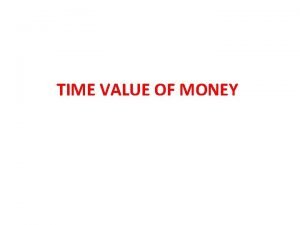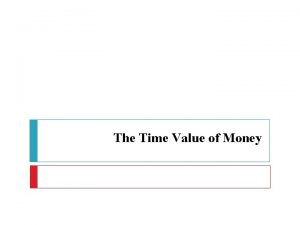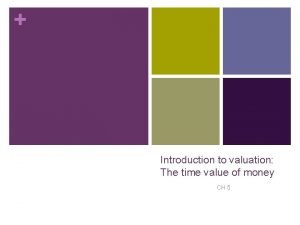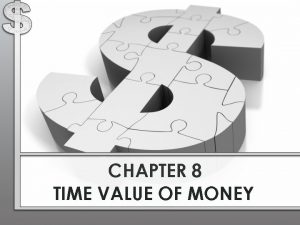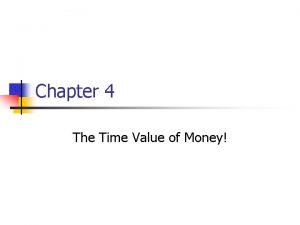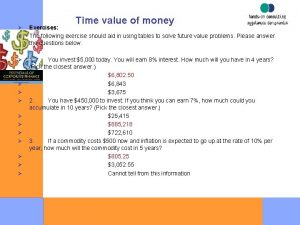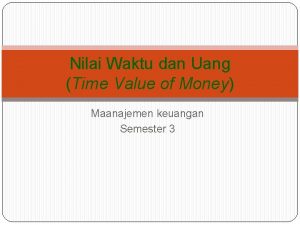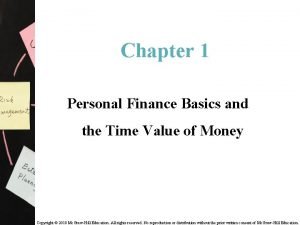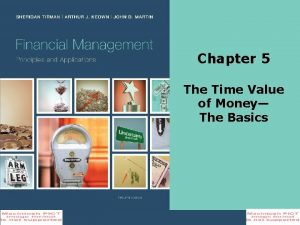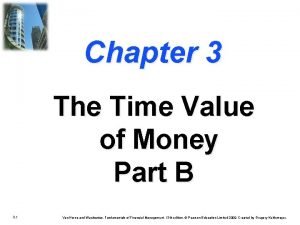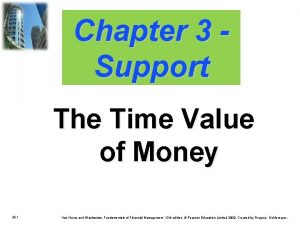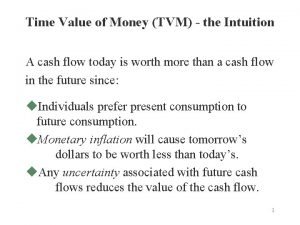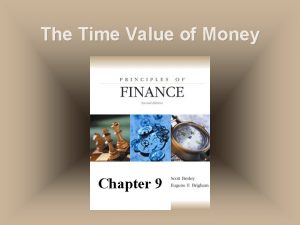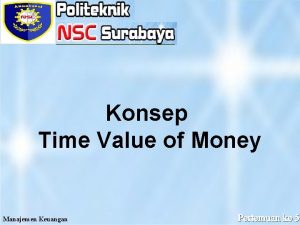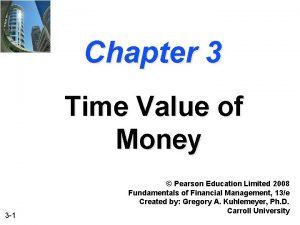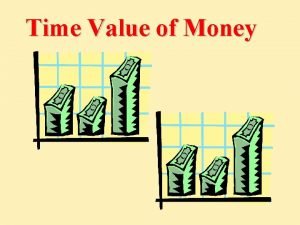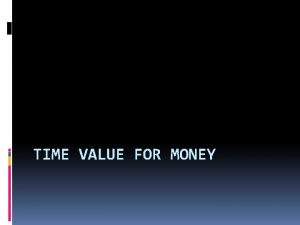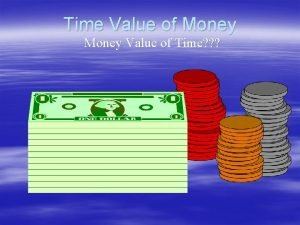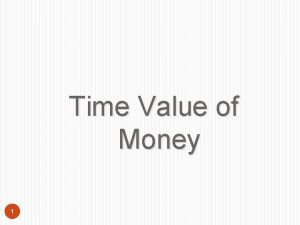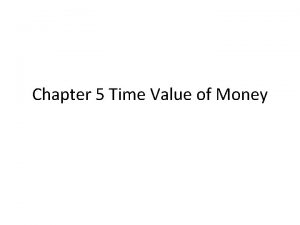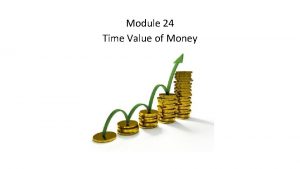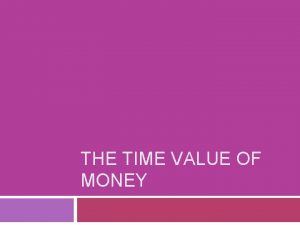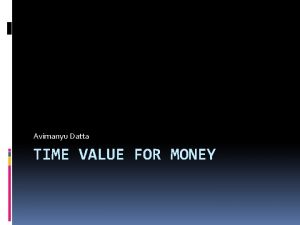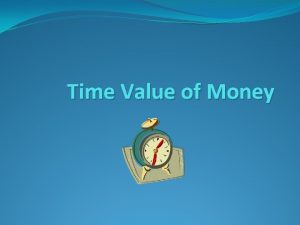Time Value of Money Time Value of Money















![FREQUENCY OF COMPOUNDING General Formula: FVn = PV 0(1 + [r/m])mn n: Number of FREQUENCY OF COMPOUNDING General Formula: FVn = PV 0(1 + [r/m])mn n: Number of](https://slidetodoc.com/presentation_image_h2/325821fd96c9f09422fe86f6846dffae/image-16.jpg)



- Slides: 19

Time Value of Money

Time Value of Money Basic Problem: How to determine value today of cash flows that are expected in the future? Time value of money refers to the fact that a dollar in hand today is worth more than a dollar promised at some time in the future Which would you rather have -- $1, 000 today or $1, 000 in 5 years? Obviously, $1, 000 today Money received sooner rather than later allows one to use the funds for investment or consumption purposes. This concept is referred to as the TIME VALUE OF MONEY!! MONEY TIME allows one the opportunity to postpone consumption and earn INTEREST

Factors affecting time value of money by “n“ l Interest rate : denoted by “r” l Amount invested : denoted by “PV” l Time : denoted

Difference between simple interest and compound interest? q. Simple interest: Interest is earned only on the principal amount. q. Compound interest: Interest is earned on both the principal and accumulated interest of prior periods.

Future Value and Compounding Future value refers to the amount of money an investment will grow to over some length of time at some given interest rate To determine the future value of a single cash flows, we need: present value of the cash flow (PV) interest rate (r), and time period (n) FVn = PV 0 × (1 + r)n Future Value Interest Factor at ‘r’ rate of interest for ‘n’ time periods

Doubling Period Rule of 72 72 Rate of Interest Rule of 69 0. 35 + 69 Rate of Interest

If you invested $2, 000 today in an account that pays 6% 6 interest, with interest compounded annually, how much will be in the account at the end of two years if there are no withdrawals? 0 6% 1 2 $2, 000 FV

FV 1 = PV (1+r)n = $2, 000 (1. 06)2 = $2, 247. 20 FV = PV = r = n = future value, a value at some future point in time present value, a value today which is usually designated as time 0 rate of interest per compounding period number of compounding periods

l John wants to know how large his $5, 000 deposit will become at an annual compound interest rate of 8% at the end of 5 years 0 8% 1 2 3 4 5 $5, 000 FV 5

u Calculation based on general formula: = PV (1+r)n u FV 5 u = $5, 000 (1+ 0. 08)5 = $7, 346. 64 FVn

Present Value and Discounting The current value of future cash flows discounted at the appropriate discount rate over some length of time period Discounting is the process of translating a future value or a set of future cash flows into a present value. To compute present value of a single cash flow, we need: Future value of the cash flow (FV) Interest rate (r) and Time Period (n) PV 0 = FVn (1 + r)n

Assume that you need to have exactly $4, 000 saved 10 years from now. How much must you deposit today in an account that pays 6% interest, compounded annually, so that you reach your goal of $4, 000? 0 6% 5 10 $4, 000 PV 0

PV 0 = FV / (1+r)10 = $4, 000 / (1. 06)10 = $2, 233. 58 0 6% 5 10 $4, 000 PV 0

John needs to know how large of a deposit to make today so that the money will grow to $2, 500 in 5 years. Assume today’s deposit will grow at a compound rate of 4% annually. 0 4% 1 2 3 4 5 $2, 500 PV 0

l Calculation based on general formula: PV 0 = FVn / (1+r)n PV 0 = $2, 500/(1. 04)5 = $2, 054. 81
![FREQUENCY OF COMPOUNDING General Formula FVn PV 01 rmmn n Number of FREQUENCY OF COMPOUNDING General Formula: FVn = PV 0(1 + [r/m])mn n: Number of](https://slidetodoc.com/presentation_image_h2/325821fd96c9f09422fe86f6846dffae/image-16.jpg)
FREQUENCY OF COMPOUNDING General Formula: FVn = PV 0(1 + [r/m])mn n: Number of Years m: Compounding Periods per Year r: Annual Interest Rate FVn, m: FV at the end of Year n PV 0: PV of the Cash Flow today

Frequency of Compounding Example l Suppose, you deposit $1, 000 in an account that pays 12% interest compounded quarterly. How much will be in the account after eight years if there are no withdrawals? PV = $1, 000 r = 12%/4 = 3% per quarter n = 8 x 4 = 32 quarters

Solution based on formula: FV= PV (1 + r)n = 1, 000(1. 03)32 = 2, 575. 10

 Dana damian
Dana damian Tabel nilai kini anuitas due of 1
Tabel nilai kini anuitas due of 1 Objective of time value of money
Objective of time value of money Introduction to valuation the time value of money
Introduction to valuation the time value of money Chapter 8 time value of money answer key
Chapter 8 time value of money answer key Time value of money quiz
Time value of money quiz Time value of money exercise
Time value of money exercise Faktor yang mempengaruhi time value of money
Faktor yang mempengaruhi time value of money Diskusi tentang time value of money
Diskusi tentang time value of money Personal finance basics and the time value of money
Personal finance basics and the time value of money Time value of money
Time value of money Chapter 3 time value of money problem solutions
Chapter 3 time value of money problem solutions Chapter 3 time value of money problem solutions
Chapter 3 time value of money problem solutions Time value of money
Time value of money Chapter 2 time value of money solutions
Chapter 2 time value of money solutions Pengertian time value of money
Pengertian time value of money Chapter 3 time value of money problem solutions
Chapter 3 time value of money problem solutions Value creation value delivery value capture
Value creation value delivery value capture Gatsby historical background
Gatsby historical background Money smart money match
Money smart money match

